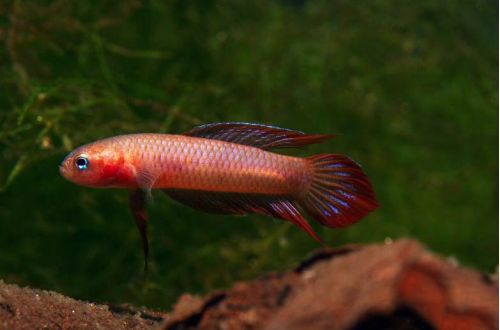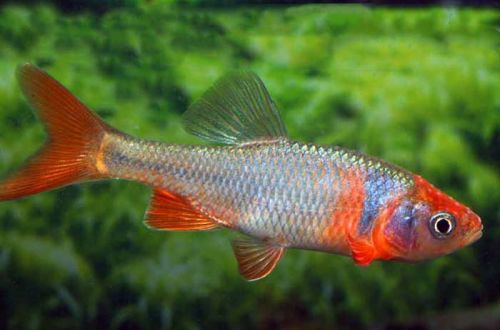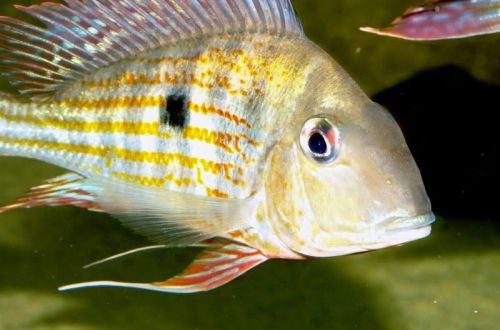
betta bordeaux
Bordeaux Betta or Bordeaux Cockerel, scientific name Betta burdigala, belongs to the Osphronemidae family. The fish has a beautiful red color, which reminded French explorers of the color of popular Bordeaux wines, after which it was named. In its natural habitat, it is endangered, therefore it is practically not exported for sale. Very rare in hobby aquariums.

Contents
Habitat
It comes from Southeast Asia from the islands of Bangka and Belitung, located off the east coast of Sumatra. They inhabit peat bogs and associated streams and rivers flowing through the rainforest. A typical biotope is a shallow reservoir, the bottom of which is littered with plant debris (branches, leaves, various snags), and the water has a rich brown color due to the high concentration of humic acids and other tannins. Reservoirs periodically dry up and the fish are forced to live among leaf debris and mud for several weeks.
Brief information:
- The volume of the aquarium – from 40 liters.
- Temperature – 22-30°C
- Value pH — 4.0–6.0
- Water hardness – 0–5 dGH
- Substrate type – any dark
- Lighting – subdued
- Brackish water – no
- Water movement – little or no
- The size of the fish is about 3 cm.
- Food – any food
- Temperament – conditionally peaceful
- Content – in a pair or group with one male and several females
Description
Adult individuals reach a length of about 3 cm. The fish have an elongated strong body. The color is red, dark pink, the fins are burgundy. Scales have a turquoise tint. Males look larger and brighter, and during the breeding season, their colors become more saturated.
Food
An omnivorous species, in home aquariums it accepts most popular foods intended for aquarium fish. A number of manufacturers produce special products for Cockerels, which are considered the most preferable because they contain the necessary set of components. If possible, frozen or live foods such as brine shrimp, daphnia, small bloodworms, etc., should be included in the daily diet.
Maintenance and care, arrangement of the aquarium
The optimal size of an aquarium for a couple or a small group of fish starts from 40 liters. The recommended design is an environment that resembles a natural reservoir: dark soil, thickets of shade-loving plants, including floating ones, and many snags. A good addition would be the addition of dried leaves of some trees, pre-soaked to prevent them from floating. They will not only add more naturalness to the design, but also become a means of giving the water a chemical composition similar to the stem in which fish live in nature. Read more in the article “Which tree leaves can be used in an aquarium.”
The most important factor in the long-term maintenance of Betta Bordeaux is the quality of the water. Suitable hydrochemistry (low pH and dGH) must be ensured and excessive accumulation of organic waste (feed residues, excrement) must be avoided. Stable water conditions depend on the regularity of certain obligatory aquarium maintenance procedures, such as cleaning and replacing part of the water with fresh water, as well as the smooth operation of the installed equipment, primarily the filtration system.
Filters are the main source of water movement, and fish do not tolerate excessive flow, being from stagnant swamps, so when choosing a specific model, you should give preference to one that does not cause or reduces to an imaginary flow of water. In some cases, a simple airlift filter with a sponge will be a good choice.
The aquarium should be equipped with a lid to keep a layer of warm, moist air under it. This is a necessary condition for the normal functioning of the labyrinth organ in the Petushkov fish.
Behavior and Compatibility
They belong to the group of fighting fish and fully justify their belonging. Intraspecific relationships are built on the competition of males with each other for position in the hierarchy. In conditions of lack of space, constant skirmishes between them are likely. It rarely comes to physical injury, but a weaker individual will be subjected to constant attacks, which is undesirable. In a small aquarium, it is desirable to maintain a group of one male and one or more females. Compatible with other non-aggressive fish of comparable size. However, species with similar coloration should be avoided, as Beta males may mistake them for rivals.
Breeding / breeding
Considered caring parents. During the breeding season, males build a nest for future offspring and guard the fry until they start to swim on their own. From this point on, parents usually lose interest in them.
With the onset of the spawning period, turquoise shades begin to appear in the color of the males and they begin to build a nest from air bubbles and plant debris on the surface of the water. The spawning process itself is accompanied by the hugs of the female and the male, during which the eggs are fertilized. The eggs are carefully picked up and carried to the nest. The fry emerge after 24–48 hours and attach to the vesicles. They remain in place for another 3-4 days. All this time, the male guards his brood and picks up the unhooked fry, carefully transferring them back.
Fish diseases
The cause of most diseases is unsuitable conditions of detention. A stable habitat will be the key to successful keeping. In the event of symptoms of the disease, first of all, the quality of the water should be checked and, if deviations are found, measures should be taken to correct the situation. If symptoms persist or even worsen, medical treatment will be required. Read more about symptoms and treatments in the Aquarium Fish Diseases section.





